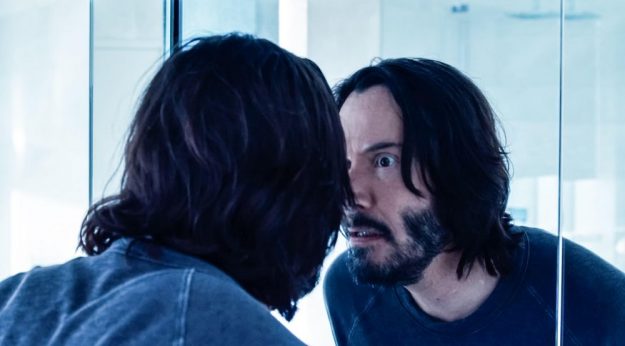At the impressionable age of twelve, my older sister and her high school friends brought me to see The Matrix. I hadn’t heard of Plato’s cave or Descartes’s demon or the Heart Sutra’s declaration that there is, in emptiness, “no eye, ear, nose, tongue, body, mind / No color, sound, smell, taste, touch, thing / No realm of sight, no realm of consciousness”—or the countless other contemplations throughout history on the limitations of human perception and consciousness that make it impossible for us to stand outside ourselves and verify that the world exists independently of us and more or less aligns with how we experience it. I didn’t even know what the premise of The Matrix was. All I knew entering the theater was that the trailer looked cool. I left with my mind blown.
I have had many eye-opening experiences, but few are as memorable as the first time I learned what it meant for my eyes to be closed. Yet the impact that The Matrix had on me (and many others, it seems) does not mean it was a profound film. If the sequels in what would become a trilogy proved anything in their attempt to further plumb the philosophical depths it was that the original wasn’t that deep to begin with: The symbolism is often heavy-handed. The understanding of the human mind was unsophisticated. The characters’ motivations and morals were black and white. Despite the disappointing and disenchanting sequels, however, I still enjoy the first movie, not as a philosophical treatise but as an innovative action film that captures fundamental questions about existence with sleek and striking imagery that is as accessible as it is unforgettable.
The latest sequel, The Matrix Resurrections, seems to understand this. Earlier attempts tried to recapture the magic of the original (which, seeing as how it ended with the protagonist, Neo (Keanu Reeves), essentially attaining enlightenment and god-like powers, was always going to be challenging). The fourth film takes a different approach. It opens with new characters searching for Neo, who they believe is alive despite his apparent death in the third film. They find him—I’d say “spoiler alert,” but Resurrections is in the title—plugged back into the matrix where he has been living as a video game designer who’s famous for creating his own Matrix trilogy. Years later, he’s been given the unenviable task of creating a fourth game. Neo sits through endless pitch meetings as collaborators deconstruct his past successes and try to figure out why it worked and how to top it.

An older, shaggier Reeves has gotten a lot of experience playing a man hanging on by a thread, with his characters often enduring a gauntlet of armed combatants, and it’s a delight to watch him put that world-weary expression to use, deadpanning eager colleagues arguing about whether the fans care more about its philosophy or mindless action or dystopian trans metaphors. Director Lana Wachowski’s cynical wit flows effortlessly, presumably from her own experiences with creative achievement, in a refreshing departure from the increasingly drab and joyless tone of the previous sequels. And as we learn more about Neo’s relationship with his work—explored through flashes of scenes from the first film—and his difficulty telling fact from fiction, characters start speaking to legitimate critiques of the earlier films, most notably its over-reliance on dichotomies.
Meanwhile, we learn that while coding his game, Neo somehow codes the matrix (or part of it). This is the most successful of a few devices that allow for some suspension of disbelief that perhaps Neo actually is outside of the matrix, and that maybe the other characters have it wrong.
Unfortunately, the possibilities that open up in the first half of the film are one-by-one closed in the second half as Resurrection rushes toward a regrettably predictable ending. While it’s still fun to see the high-speed chases and gravity-defying fight scenes, the world-building veers into introducing new sci-fi premises with no real pay off, and in the end, Neo finds himself roughly where he did at the end of the first film. Meanwhile, increasingly heavy-handed flashbacks to the original Matrix become annoying reminders that the original had a bold aesthetic that has been replaced with something that looks like most other futuristic action movies. It makes sense to update the outfits from the old skin-tight leather, but the old costumes were unique and make the new ones look uninspired.
How exactly should it be updated? I don’t know. Much of the earlier style came about in a time when hackers were mysterious and computers were exciting. They carry different associations now. Resurrections knows it, too. The film’s villain at one point says that he’s more interested in the human mind than his predecessors were. He wants to create a matrix where humans aren’t just fooled but trapped in self-defeating psychological loops. We, too, are no longer amused by technology as a thought-experiment, one that ultimately can be conquered by human perseverance. The concept of machines controlling our lives is no longer hypothetical, and while Resurrections does not offer any mind-blowing insights about this, it had to acknowledge this shift for the franchise to have a future.
The Matrix was never as profound as twelve-year-old me thought it was. What made it exceptional was how well it explored timeless themes using language and visuals that were timely, singular, and had never been seen before. With Resurrections, the Matrix franchise appears to have become self-aware enough to continue to evolve with the times.